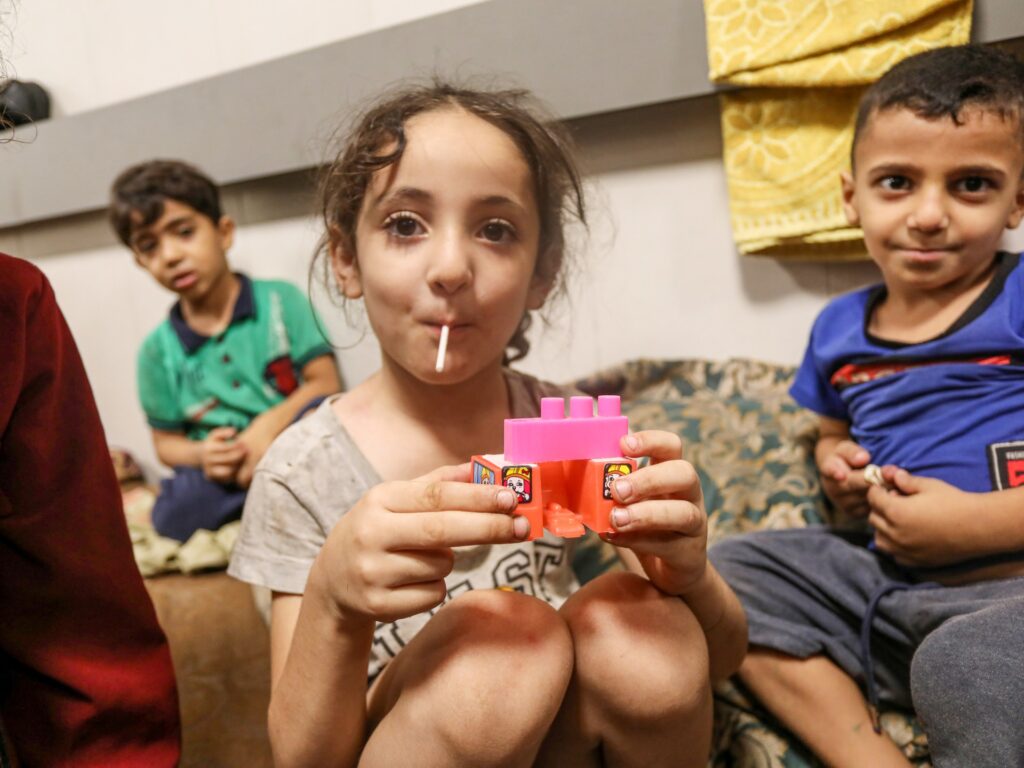Gaza City, Gaza Strip – Farah Bakr and her doll are inseparable.
When her house was partially destroyed by an Israeli air raid, she thought the doll was lost, but managed to spot her light blue dress under the debris.
” Bombs ! » said Farah. “They bombed the mosque next to us,” she continued in wonder.
The five-year-old dug up the doll and dusted it off, insisting on taking it to al-Shifa Hospital where she and her family are seeking shelter.
“She’s broken but I want her with me,” she said. “I wash her, comb her hair and put it in a ponytail.”
The constant bombing of Gaza terrifies the children living there, and Farah was no different, even when she slept.
“When the shelling gets intense, I hold her, as she starts up in her sleep,” said her older sister Shireen, 21.
Children at al-Shifa Hospital are displaced from their homes and familiar spaces, spending their days and nights in fear of the constant sound of bombs falling all around them.
Some of them managed to salvage a familiar object from the homes they were saying goodbye to, by pulling a small, brightly colored toy out of the debris like Farah did, or by picking up the nearest object they could hold in their hands.
Literally holding on to something that might remind them of home.
The extreme overcrowding of the hospital forces families to settle wherever they can find a place to settle, in the corridors, in the garden or on the floor of the hospital rooms.
Taiseer al-Sharif and his family gathered around a hospital bed with 3-year-old Jude sitting on it with a bandage on his head.
They were heading south from Gaza City towards Wadi Gaza on October 13 when Israeli warplanes targeted the vehicle next to them. The family was heading south, as the Israeli army had ordered, “for their own safety.”
“The shrapnel hit us,” Taiseer said. “Blood was flowing down our bodies. Jude was hit in the head by shrapnel and lost consciousness.
The family tried to hide behind the concrete barrier of a police checkpoint, and eventually managed to return to Gaza City on foot, with Taiseer telling his older children to walk several meters apart. on the other “so that if we were targeted, at least we wouldn’t do it.” They all die.”
An ambulance took them to Shifa and Jude woke up from his coma a day later, unable to utter a word. She suffered nerve damage in her left leg, for which she is currently undergoing physiotherapy.
She sits up in bed, clinging to a simple plastic ring toy that seems to comfort her. Her father had taken her out of the hospital ward to buy it for her.
“I try to cheer him up, take him outside to the stores to buy his favorite things, his favorite food,” his father said.
“She likes the cup noodles, but can only drink the broth at the moment. But it’s still a huge improvement compared to before,” he continued. “She is slowly regaining her speech and has stopped vomiting. Before, she wouldn’t interact with anyone.
Nearby, Batoul Abu Karesh, 10, played with his sisters with plastic fruits and vegetables, the only toys they had managed to take home, in the Karama district.
“I’m not so afraid of the bombings,” she said courageously. She and her sisters were comforted by the presence of other children around them.
“I was more afraid when we were at home.”
“I want the war to end. I wish we could all stay alive and not get lost,” she added.
Since October 7, the Israeli offensive on the Gaza Strip has killed more than 4,300 children, double the number of Palestinian children killed in the occupied West Bank and Gaza since 1967.
More than 10,500 Palestinians have been killed, nearly half of them those who followed Israeli army orders to move south. More than 2,660 Palestinians are still under the rubble, including 1,350 children.

